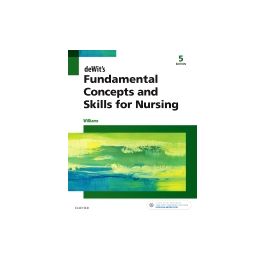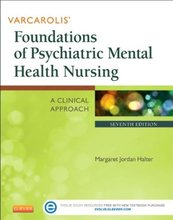This is completed downloadable of Test Bank for deWits Fundamental Concepts and Skills for Nursing 5th Edition by Williams

Product Details:
- ISBN-10 : 9780323396219
- ISBN-13 : 978-0323396219
- Author: Patricia A. Williams
Fundamental Concepts and Skills for Nursing, 5th Edition provides all the basic theoretical and applied knowledge that the LPN/LVN nurse needs to practice in an expanded number of care settings, such as the community clinic, physician’s office, long-term care facility, home, and acute-care hospital setting. With an extensive art program and thorough discussion of QSEN, this text addresses topics like the physical and psychosocial needs of the patient, critical thinking for problem solving and clinical judgment, and communication ― all within a strong nursing process framework. The accessible, friendly, and clear writing style appeals to students and instructors, and its rich ancillary package, including NCLEX-PN® review questions, gives students an edge on learning fundamentals.
- Concept maps give a visual example of concepts addressed in the text, help you visualize difficult material, and illustrate how a disorder’s multiple symptoms, treatments, and side effects are associated.
- Over 110 skills and steps, featuring sample documentation examples and Home Care Considerations boxes where appropriate, present step-by-step procedures in an action/rationale format.
- Life Span Considerations: The Older Adult highlight changes that occur with aging and how they affect nursing care by LPN/LVNs working in community and long-term care.
- Easy-to-follow reading level and text organization presents information from simple to most complex, making it perfect for lower level students and those speaking English as a second language.
- Numbered objectives, divided by theory and clinical practice, provide a framework for content.
- Cultural Considerations cover biocultural variations, as well as health promotion for specific ethnic groups, so you provide culturally competent care.
- Health Promotion and Patient Teaching boxes include guidelines to prevent illness, promote health, and develop self-care strategies.
- Nursing process framework features application of the nursing process and nursing care plans to reinforce application of the nursing process in the clinical setting.
- Think Critically boxes encourage you to synthesize information and apply concepts to practice.
- Home Care Considerations boxes highlight the necessary adaptations of nursing skills and techniques for the patient in the home care setting.
- Communication boxes present examples of nurse-patient dialogues and instructive therapeutic communication techniques.
- Over 20 nursing care plans, which include critical thinking questions at the end of the text, provide you with a model for planning patient care.
- Clinical chapters provide an overview of structure and function to give you a refresher in related anatomy and physiology, including a section on aging.
- Key terms include phonetic pronunciations, which are helpful for ESL students, and text page references to find the definition.
- Standard LPN Threads features include helpful characteristics such as full-color design, key terms, numbered objectives, key points, critical thinking questions, critical thinking activities, glossary, and references.
- NEW! Nursing Concepts and Exemplars listed for each chapter to support concept curriculums.
- NEW! Discussion of QSEN and highlighted Safety information provides you with the knowledge, skills, and attitudes necessary to continuously improve the quality and safety of patient care.
- EXPANDED! Evidence-Based Practice boxes and highlighted best practices point out the most current, evidence-based information.
- UPDATED! Expanded art program with original photos and line art better illustrates nursing concepts.
Table of Content:
- Unit I. Introduction to Nursing and the Health Care System
- chapter 1. Nursing and the Health Care System
- Historical Overview
- The Art and Science of Nursing
- Nursing Education Pathways
- Delivery of Nursing Care
- Practice Settings
- Today’s Health Care System
- The Patient Protection and Affordable Care Act
- Get Ready for the NCLEX Examination!
- chapter 2. Concepts of Health, Illness, Stress, and Health Promotion
- Health and Illness
- Traditional Views of Health and Illness
- Current Views of Health and Illness
- The Consumer Concept of Health and Illness
- The Holistic Approach
- Homeostasis
- Health Promotion and Illness Prevention
- Get Ready for the NCLEX Examination!
- chapter 3. Legal and Ethical Aspects of Nursing
- Source of Law
- Civil and Criminal Law
- Laws Related to Nursing Practice and Licensure
- Laws and Guidelines Affecting Nursing Practice
- Legal Documents
- Violations of Law
- Ethics in Nursing
- Get Ready for the NCLEX Examination!
- Unit II. The Nursing Process
- chapter 4. The Nursing Process and Critical Thinking
- The Nursing Process
- Critical Thinking
- Critical Thinking in Nursing
- Priority Setting and Work Organization
- Application of Problem Solving and Clinical Reasoning
- Get Ready for the NCLEX Examination!
- chapter 5. Assessment, Nursing Diagnosis, and Planning
- Assessment (Data Collection)
- Nursing Diagnosis
- Planning
- Get Ready for the NCLEX Examination!
- chapter 6. Implementation and Evaluation
- Implementation
- Interdisciplinary Care
- Evaluation
- Evaluation in Long-Term Care
- Evaluation in Home Health Care
- Revision of the Nursing Care Plan
- Quality Improvement
- Constructing a Nursing Care Plan
- Get Ready for the NCLEX Examination!
- Unit III. Communication in Nursing
- chapter 7. Documentation of Nursing Care
- Purposes of Documentation
- Documentation and the Nursing Process
- The Medical Record
- Methods of Documentation (Charting)
- The Documentation Process
- Get Ready for the NCLEX Examination!
- chapter 8. Communication and the Nurse-Patient Relationship
- The Communication Process
- Therapeutic Communication Techniques
- Blocks to Effective Communication
- Interviewing Skills
- The Nurse-Patient Relationship
- Nurse-Patient Communication
- Communication within the Health Care Team
- Communication in the Home and Community
- Get Ready for the NCLEX Examination!
- chapter 9. Patient Education and Health Promotion
- Purposes of Patient Education
- Modes of Learning
- Assessment of Learning Needs
- The Patient Education Plan
- Coordination with Discharge Planning
- Get Ready for the NCLEX Examination!
- chapter 10. Delegation, Leadership, and Management
- The Chain of Command
- Leadership Styles
- Keys to Effective Leadership
- Leadership Roles
- Management Skills for the Licensed Practical Nurse/Licensed Vocational Nurse
- Risk Management
- Get Ready for the NCLEX Examination!
- Unit IV. Developmental, Psychosocial, and Cultural Considerations
- chapter 11. Growth and Development: Infancy Through Adolescence
- Overview of Structure and Function
- Age Groups
- Theories of Development
- Principles of Growth and Development
- Prenatal Development
- Infants
- Young Children
- Middle and Older Children
- Adolescents
- Get Ready for the NCLEX Examination!
- chapter 12. Adulthood and the Family
- Adulthood as Continuing Change
- Theories of Development
- Families
- Young Adults
- Middle Adulthood
- Get Ready for the NCLEX Examination!
- chapter 13. Promoting Healthy Adaptation to Aging
- Overview of Aging
- Physical Changes
- Cognitive Aspects of Aging
- Psychosocial Aspects of Aging
- When a Parent Needs Help
- Get Ready for the NCLEX Examination!
- chapter 14. Cultural and Spiritual Aspects of Patient Care
- Transcultural Care
- Major Religions in the United States and Canada
- Developing Cultural Competence
- Cultural Differences
- Nursing Process in Transcultural Nursing
- Get Ready for the NCLEX Examination!
- chapter 15. Loss, Grief, and End-of-Life Care
- Nurses’ Attitudes Toward End-of-Life Care
- Change, Loss, and Grief
- Death and Dying
- Nursing and the Dying Process
- Application of the Nursing Process
- Signs of Impending Death
- Legal and Ethical Aspects of Life-and-Death Issues
- Postmortem (After Death) Care
- Get Ready for the NCLEX Examination!
- Unit V. Basic Nursing Skills
- chapter 16. Infection Prevention and Control: Protective Mechanisms and Asepsis
- Infectious Agents
- Process (Chain) of Infection
- Body Defenses Against Infection
- Asepsis and Control of Microorganisms
- Sepsis in the Home Environment
- Infection Control Surveillance
- Get Ready for the NCLEX Examination!
- chapter 17. Infection Prevention and Control in the Hospital and Home
- Infection
- Infection Prevention and Control
- Personal Protective Equipment
- Application of the Nursing Process
- Get Ready for the NCLEX Examination!
- chapter 18. Safely Lifting, Moving, and Positioning Patients
- Overview of the Structure and Function of the Musculoskeletal System
- What are the Functions of Bones for Positioning and Moving Patients?
- What are the Functions of Muscles for Positioning and Moving Patients?
- What Changes in the System Occur with Aging?
- Principles of Body Movement for Nurses
- Principles of Body Movement for Patients
- Application of the Nursing Process
- Get Ready for the NCLEX Examination!
- chapter 19. Assisting With Hygiene, Personal Care, Skin Care, and the Prevention of Pressure Injuries
- Overview of the Structure and Function of the Integumentary System
- Application of the Nursing Process
- Get Ready for the NCLEX Examination!
- chapter 20. Patient Environment and Safety
- Factors Affecting the Environment
- Patient Unit
- Safety
- Protective Devices
- Get Ready for the NCLEX Examination!
- chapter 21. Measuring Vital Signs
- Overview of Structure and Function Related to the Regulation of Vital Signs
- Measuring Body Temperature
- Application of the Nursing Process
- Measuring the Pulse
- Application of the Nursing Process
- Measuring Respirations
- Measuring the Blood Pressure
- Application of the Nursing Process
- Pain, the Fifth Vital Sign
- Automated Vital Sign Monitors
- Documenting Vital Signs
- Get Ready for the NCLEX Examination!
- chapter 22. Assessing Health Status
- Data Collection and Assessment
- Application of the Nursing Process
- Get Ready for the NCLEX Examination!
- chapter 23. Admitting, Transferring, and Discharging Patients
- Types of Admissions
- Admission Process
- Patient Transfer to Another Hospital Unit
- Discharging the Patient
- Death of a Patient
- Get Ready for the NCLEX Examination!
- chapter 24. Diagnostic Tests and Specimen Collection
- Diagnostic Tests and Procedures
- Application of the Nursing Process
- Get Ready for the NCLEX Examination!
- Unit VI. Meeting Basic Physiologic Needs
- chapter 25. Fluid, Electrolyte, and Acid-Base Balance
- Composition of Body Fluids
- Distribution of Body Fluids
- Fluid and Electrolyte Imbalances
- Acid-Base Balance
- Acid-Base Imbalances
- Application of the Nursing Process
- Get Ready for the NCLEX Examination!
- chapter 26. Concepts of Basic Nutrition and Cultural Considerations
- Overview of the Structure and Function of the Gastrointestinal System
- Dietary Guidelines
- Protein
- Vegetarian Diets
- Carbohydrates
- Fats (Lipids)
- Vitamins
- Minerals
- Water
- Factors that Influence Nutrition
- Cultural Influences on Nutrition
- Nutritional Needs Throughout the Life Span
- Application of the Nursing Process
- Get Ready for the NCLEX Examination!
- chapter 27. Nutritional Therapy and Assisted Feeding
- The Goals of Nutritional Therapy
- The Postoperative Patient
- Health Issues Related to Nutrition
- Disease Processes that Benefit from Nutritional Therapy
- Assisted Feeding
- Application of the Nursing Process
- Get Ready for the NCLEX Examination!
- chapter 28. Assisting with Respiration and Oxygen Delivery
- Overview of the Structure and Function of the Respiratory System
- Hypoxemia
- Airway Obstruction and Respiratory Arrest
- Clearing Respiratory Secretions
- Oxygen Administration
- Artificial Airways
- Chest Drainage Tubes
- Application of the Nursing Process
- Get Ready for the NCLEX Examination!
- chapter 29. Promoting Urinary Elimination
- Overview of Structure and Function of the Urinary System
- Normal Urinary Elimination
- Alterations in Urinary Elimination
- Application of the Nursing Process
- Get Ready for the NCLEX Examination!
- chapter 30. Promoting Bowel Elimination
- Overview of the Structure and Function of the Intestinal System
- Characteristics of Stool
- Hypoactive Bowel and Constipation
- Hyperactive Bowel and Diarrhea
- Fecal Incontinence
- Application of the Nursing Process
- Rectal Suppositories
- Enemas
- Rectal Tube
- Fecal Impaction
- Bowel Training for Incontinence
- Bowel Ostomy
- Get Ready for the NCLEX Examination!
- chapter 31. Pain, Comfort, and Sleep
- Pain and Discomfort
- Application of the Nursing Process
- Sleep
- Application of the Nursing Process
- Get Ready for the NCLEX Examination!
- chapter 32. Complementary and Alternative Therapies
- Complementary and Alternative Medicine
- Mind and Body Interventions
- Natural Products
- Other Complementary Interventions
- The Nurse’s Role in Complementary and Alternative Therapies
- Get Ready for the NCLEX Examination!
- Unit VII. Medication Administration
- chapter 33. Pharmacology and Preparation for Drug Administration
- Pharmacology
- Medication Administration and Safety
- Application of the Nursing Process
- Get Ready for the NCLEX Examination!
- chapter 34. Administering Oral, Topical, and Inhalant Medications
- Nursing Responsibilities in Medication Administration
- Medication Orders
- Medication Administration Systems
- Topical Drugs
- Application of the Nursing Process
- Medication Errors
- Get Ready for the NCLEX Examination!
- chapter 35. Administering Intradermal, Subcutaneous, and Intramuscular Injections
- Principles of Parenteral Injections
- Routes for Parenteral Medication
- Injection Equipment
- Parenteral Solutions
- Application of the Nursing Process
- Get Ready for the NCLEX Examination!
- chapter 36. Administering Intravenous Solutions and Medications
- Intravenous Therapy
- Licensed Practical Nurse/Licensed Vocational Nurse’s Role in Intravenous Therapy
- Types of Intravenous Solution
- Equipment for Intravenous Administration
- Complications of Intravenous Therapy
- Application of the Nursing Process
- Get Ready for the NCLEX Examination!
- Unit VIII. Care of the Surgical and Immobile Patient
- chapter 37. Care of the Surgical Patient
- Reasons for Surgery
- Patients at Higher Risk for Surgical Complications
- Perioperative Nursing
- Enhancements to Surgical Technique
- Anesthesia
- Preoperative Procedures
- Application of the Nursing Process
- Postoperative Care
- Get Ready for the NCLEX Examination!
- chapter 38. Providing Wound Care and Treating Pressure Injuries
- Types of Wounds and the Healing Process
- Phases of Wound Healing
- Factors Affecting Wound Healing
- Complications of Wound Healing
- Treatment of Wounds
- Treatment of Pressure Injuries or Vascular Ulcers
- Application of the Nursing Process
- Get Ready for the NCLEX Examination!
- chapter 39. Promoting Musculoskeletal Function
- Systemic Effect of Immobilization
- Psychosocial Effects of Immobilization
- Types of Immobilization
- Devices Used to Prevent Problems of Immobility
- Therapeutic Exercise
- Application of the Nursing Process
- Get Ready for the NCLEX Examination!
- Unit IX. Caring for the Elderly
- chapter 40. Common Physical Care Problems of the Older Adult
- Getting Older
- Immobility
- Alteration in Elimination
- Alteration in Nutrition
- Sensory Deficits
- Sexuality
- Polypharmacy
- Get Ready for the NCLEX Examination!
- chapter 41. Common Psychosocial Care Problems of the Older Adult
- Changes in Cognitive Functioning in Older Adults
- Assessment of Cognitive Changes in Older Adults
- Common Cognitive Disorders in Older Adults
- Safety for the Cognitively Impaired
- Depression, Alcoholism, and Suicide
- Crimes Against Older Adults
- Future Issues of Concern to Older Adults
- Get Ready for the NCLEX Examination!
- Appendixes
- appendix A. Standard Steps for All Nursing Procedures
- appendix B. NFLPN Nursing Practice Standards for the Licensed Practical/Vocational Nurse
- appendix C. American Nurses Association Code of Ethics for Nurses
- appendix D. Standard Precautions
- appendix E. Most Common Laboratory Test Values
- appendix F. NANDA-I Approved Nursing Diagnoses, 2015-2017
- Reader References
- Glossary
- Index





